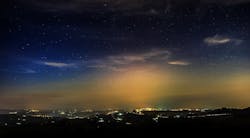Preventing Light Pollution: What to Consider When Selecting Outdoor Lighting
We see stories in the news almost every day about the increase in light pollution and its impact on humans and the environment. Research published in 2022 revealed an increase in sky brightness of nearly 10 percent per year from 2011 to 2022 that is attributed to the increased use of LED outdoor lighting, so it’s more important than ever to ensure that outdoor lighting installed today doesn’t add to the problem.
No one intentionally installs lighting to cause more light pollution, but installers may not be aware of methods to avoid it. In many cases, the replacement LED technology is based on using existing poles and matching the lumen output of the existing lighting, without considering the improved distribution of the LED light fixtures. This can lead to over lighting because newer LED light fixtures tend to produce more uniform lighting than older high-pressure sodium (HPS) or metal halide (MH) light fixtures.
Increased light pollution is also associated with higher correlated color temperatures (CCT) (light sources with higher CCTs also appear brighter to many people), and high angle light and uplight (e.g., tilting the luminaire up to cover a larger area also results in more light at higher angles, which increases light pollution). A best practice is to have a qualified lighting professional perform modeling to determine what the spread of light will look like and then select products and create a specification for the replacement LED fixtures based on the target application needs. The DesignLights Consortium (DLC) created a resource, "Seven strategies to minimize negative impacts of outdoor light at night", to help guide lighting selection to mitigate light pollution.
The DLC team recently returned from Lightfair, where several conference sessions focused on harm due to light pollution and the need to mitigate this. Many manufacturers featured products that are readily available in warm white 2700-3000 Kelvin CCT and a few were showing products in 2200K that are much closer in color to legacy HPS fixtures that people are used to, but with the benefits of LED. This is promising as many wildlife sensitive applications require these warmer, lower CCT light sources.
As more information becomes available about light pollution and how to mitigate it, communities are passing bylaws and ordinances to limit the color and brightness of the light and ensure that products do not shine light upward (which causes sky glow), into adjacent properties and windows (light trespass), and that color temperatures of 3000K and below are selected. Nearly two dozen states have laws regulating outdoor light at night in some way. You can view a map on the DLC website showing which states, Canadian provinces, and local governments have outdoor lighting ordinances.. The DLC recently published sample lighting ordinance language that communities can integrate into their own bylaws and rulemaking so that lighting installed meets their energy efficiency and environmental goals, as well as mitigating light pollution and light trespass. Because many lighting manufacturers offer the same light fixtures in multiple color light options, having an ordinance makes it clear what a city’s expectations are. Ordinance language is the best tactic for communities to manage which outdoor lighting products can be installed in their community. Additional resources for communities are available on the DLC website.
The DLC’s LUNA specifications are built on our requirements for solid-state lighting (i.e., LED) luminaires, identifying energy efficient luminaires that also minimize light pollution, are controllable, provide appropriate visibility for people and limit negative impacts to the environment. Eligibility requirements include a limit of 3000K as the maximum CCT, as well as requirements that limit uplight and tilting (which helps mitigate glare) and ensure that the light can be dimmed or turned off when not needed. The LUNA Qualified Products List (QPL) provides an easy way to select products that meet all these goals. The DLC’s website contains more details about the DLC’s LUNA program and related information.
DLC Program Director Liesel Whitney-Schulte’s responsibilities include oversight of the DLC’s stakeholder outreach and engagement, communications, and membership. A member of the DLC staff since 2015, Liesel was previously responsible for operational oversight of the Solid-State Lighting Qualified Products List and technical development support. Liesel has more than 20 years of experience working on utility energy efficiency programs and collaborating with lighting designers to create programs that simultaneously fit utility goals and promote quality lighting design. She is Lighting Certified (LC) by the National Council on Qualifications for the Lighting Professions (NCQLP), on the NCQLP Board of Directors, and an active member of the Illuminating Engineering Society of North America (IES).
About the Author

Liesel Whitney-Schulte
DLC Program Director Liesel Whitney-Schulte’s responsibilities include oversight of the DLC’s stakeholder outreach and engagement, communications, and membership. A member of the DLC staff since 2015, Liesel was previously responsible for operational oversight of the Solid-State Lighting Qualified Products List and technical development support. Liesel has more than 20 years of experience working on utility energy efficiency programs and collaborating with lighting designers to create programs that simultaneously fit utility goals and promote quality lighting design. She is Lighting Certified (LC) by the National Council on Qualifications for the Lighting Professions (NCQLP), on the NCQLP Board of Directors, and an active member of the Illuminating Engineering Society (IES).
